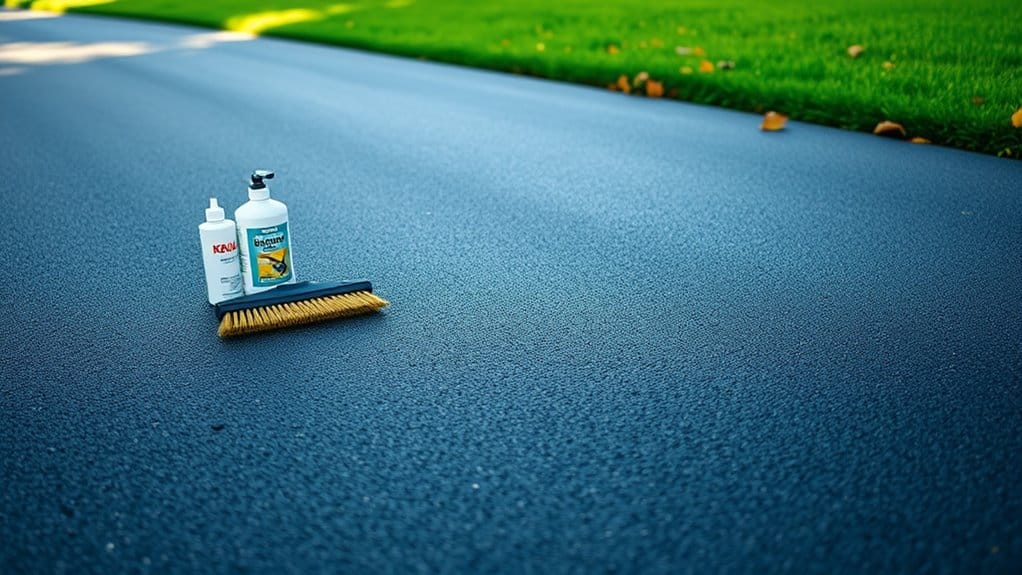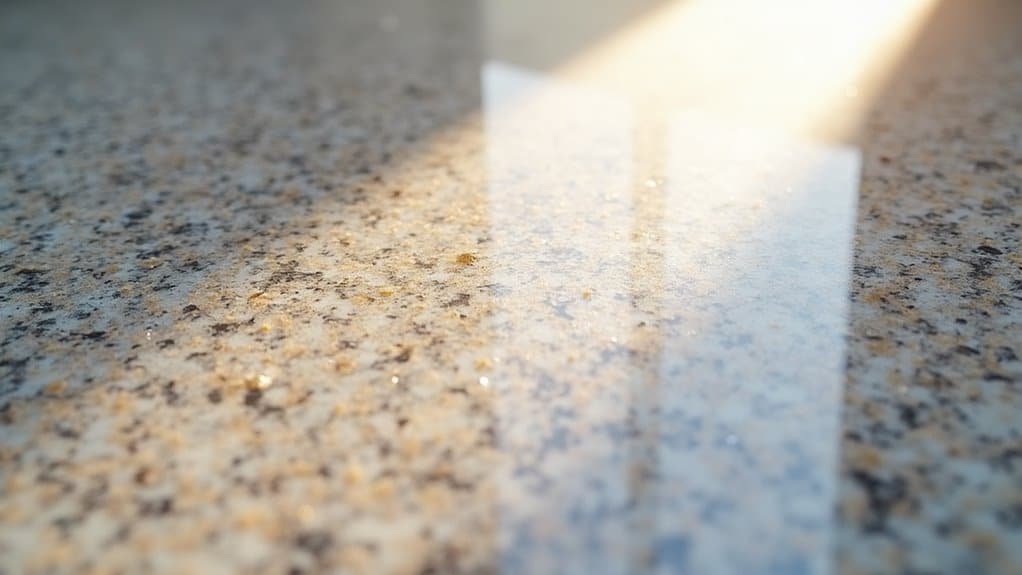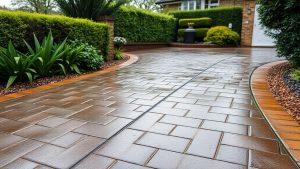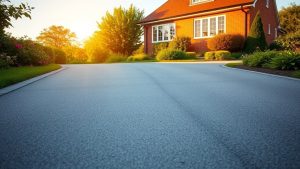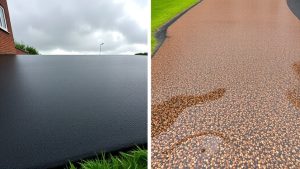To maintain your tarmac driveway each year, start by regularly sweeping away debris and pressure washing to remove stains. Treat oil spots quickly with a mix of soap and baking soda. Keep an eye out for moss and algae, using eco-friendly cleaners when necessary. Apply sealant in the summer for added protection. Regularly inspect for cracks and potholes, and repair them as needed. By staying on top of these tasks, you'll ensure your driveway remains in excellent condition. For more tips on seasonal care and maintenance, explore further resources.
Table of Contents
ToggleKey Takeaways
Tarmac Driveway Maintenance Schedule: Annual Checklist
- Inspect the driveway once a year for cracks, potholes, and stains to catch any issues early.
- Sweep away debris regularly to stop moisture build-up which can damage the tarmac.
- Treat for weeds and moss once a year with eco-friendly products to keep the driveway safe and tidy.
- Pressure wash the driveway every 3-6 months to remove dirt and stains, helping to maintain its condition.
- Apply sealant in summer to protect against UV damage and prolong the lifespan of your tarmac driveway.
Sweeping and Debris Removal
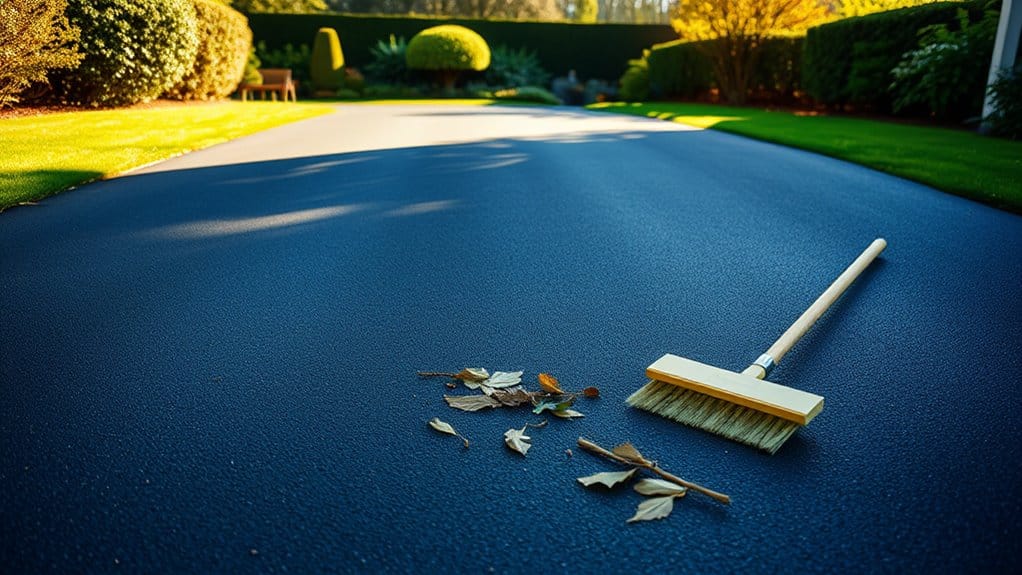
A well-maintained tarmac driveway begins with regular sweeping and debris removal. Aim to sweep at least once a week to keep it looking tidy. In autumn, increase your sweeping frequency to tackle fallen leaves and other debris. Use stiff-bristled brooms or leaf blowers for effective removal, and remember to pick up larger items like stones or branches by hand first. Collect all debris and dispose of it properly to avoid attracting pests. This routine not only improves your driveway's appearance but also prevents long-term damage and extends its lifespan.
Pressure Washing and Stain Removal
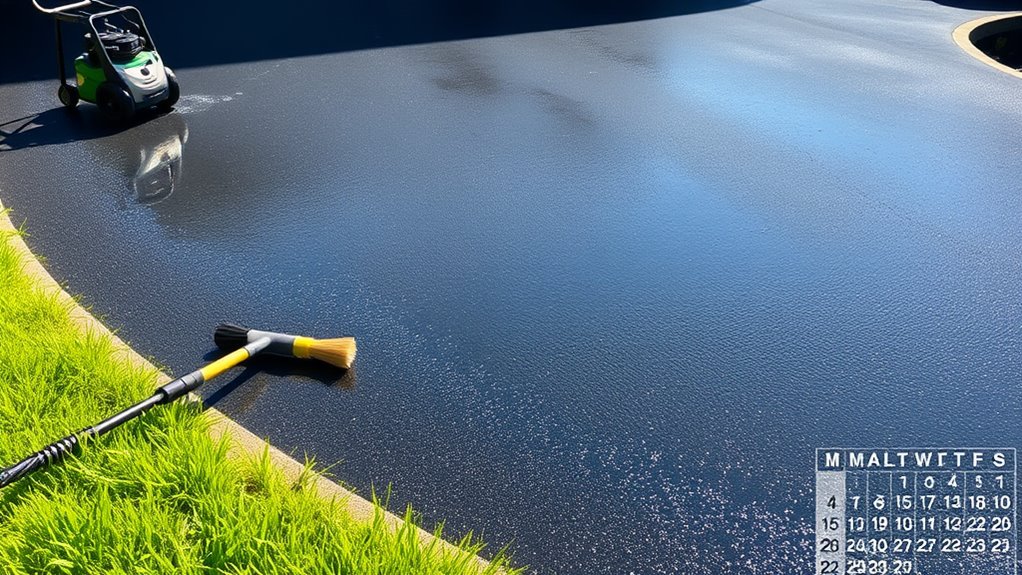
Regular sweeping effectively removes loose debris, but for deeper cleaning and stain removal on your tarmac driveway, pressure washing is key. Use moderate PSI to avoid damaging the surface and opt for a wide fan nozzle. Switch from 15° jets to 45° jets to achieve optimal results when cleaning tarmac, and keep a safe distance while using sweeping motions for an even clean.
For stubborn stains like moss and algae, pre-treat with eco-friendly cleaners and let them sit briefly for the best results. After pressure washing, rinse thoroughly to ensure all cleaning products are washed away. Aim to maintain your driveway every 3-6 months depending on how dirty it gets.
Always let it dry completely before applying any sealants. This simple maintenance keeps your driveway looking sharp and extends its lifespan.
Oil Spot Treatment
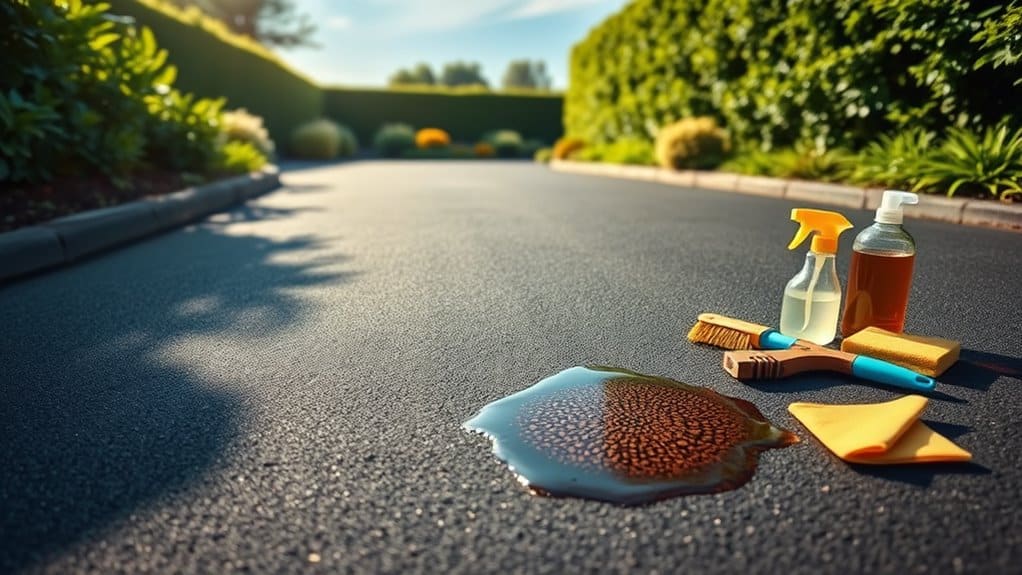
Addressing oil spots quickly can prevent lasting damage to your tarmac driveway. Start by identifying the oil stains; fresh ones are much easier to remove than older marks.
Mix dish soap with hot water to break down the oil effectively. For any remaining residue, sprinkle baking soda to absorb it. If the stains don't budge, you might want to try commercial degreasers or WD-40—just remember to wear protective gloves. Commercial degreasers are specifically formulated for oil and grease removal, making them a valuable tool for stubborn stains.
Use a stiff-bristled brush to scrub the area, and a pressure washer can help rinse it off thoroughly. For fresh stains, covering them with cat litter can help soak up excess oil.
Make sure the area is completely dry before applying any sealants. Regular maintenance and seasonal cleaning will keep your driveway looking its best.
Moss and Algae Control
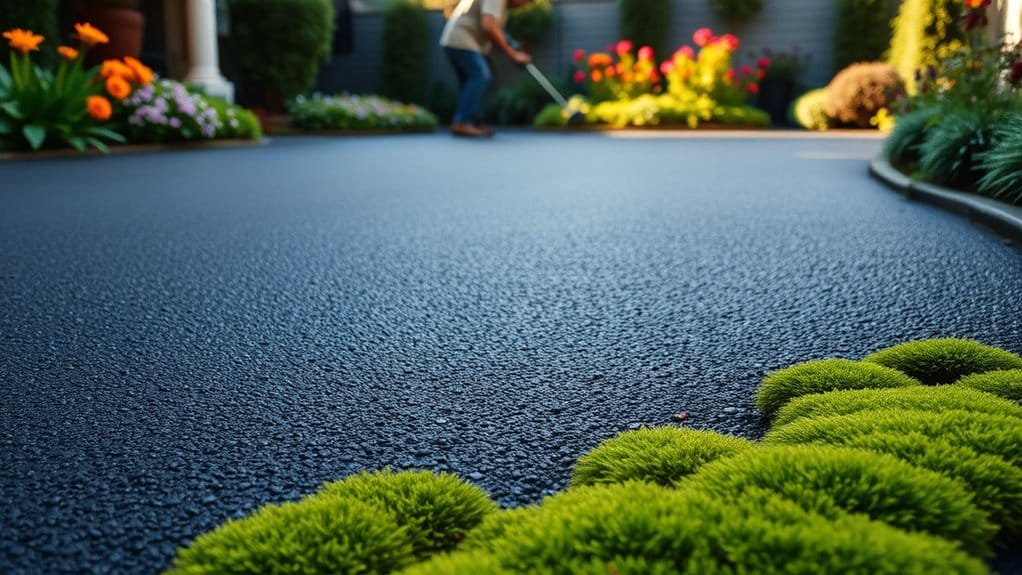
Moss and algae can quickly take over your tarmac driveway if not managed properly, so it's important to take action to maintain its appearance and lifespan.
Start by identifying any early signs of growth, particularly in shaded areas. To prevent algae, ensure proper drainage and allow more sunlight by trimming back overhanging branches. Regularly sweep and clean your driveway to remove debris that holds moisture.
For treatment, boiling water or a vinegar solution can effectively kill existing moss and algae. A pressure washer is also effective for physical removal, while eco-friendly products like Wet & Forget can help prevent future growth.
Regular maintenance will keep your driveway looking its best throughout the year.
Sealant Application
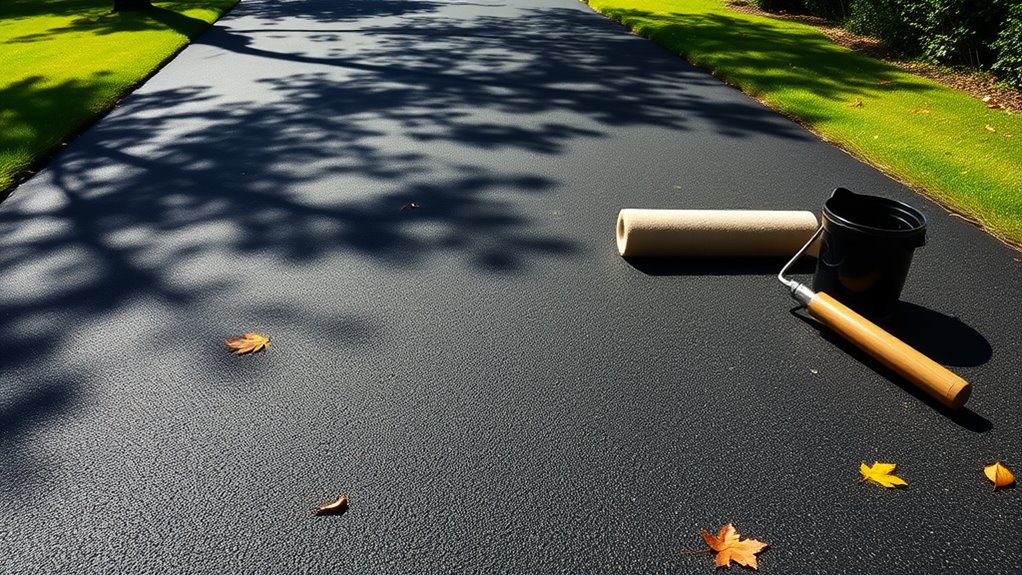
To ensure your tarmac driveway remains in good condition, applying a sealant is essential. You have several types to choose from, including acrylic, oil-based, and water-based sealants, each offering distinct advantages.
| Sealant Type | Durability | Drying Time |
|---|---|---|
| Acrylic Sealants | High | Quick |
| Oil-Based Sealants | Long-lasting | Slower |
| Water-Based Sealants | Eco-friendly | Moderate |
| Blended Sealants | Cost-effective | Moderate |
| Specialized Formulas | Specific use | Varies |
For application, you can use methods such as a brush, sprayer, or squeegee. Make sure the weather is dry and temperatures are above 10°C (50°F) before starting, and prepare the surface properly to achieve the best results. Regularly applying a tarmac sealer can help maintain driveway integrity and aesthetics.
Crack and Pothole Repairs
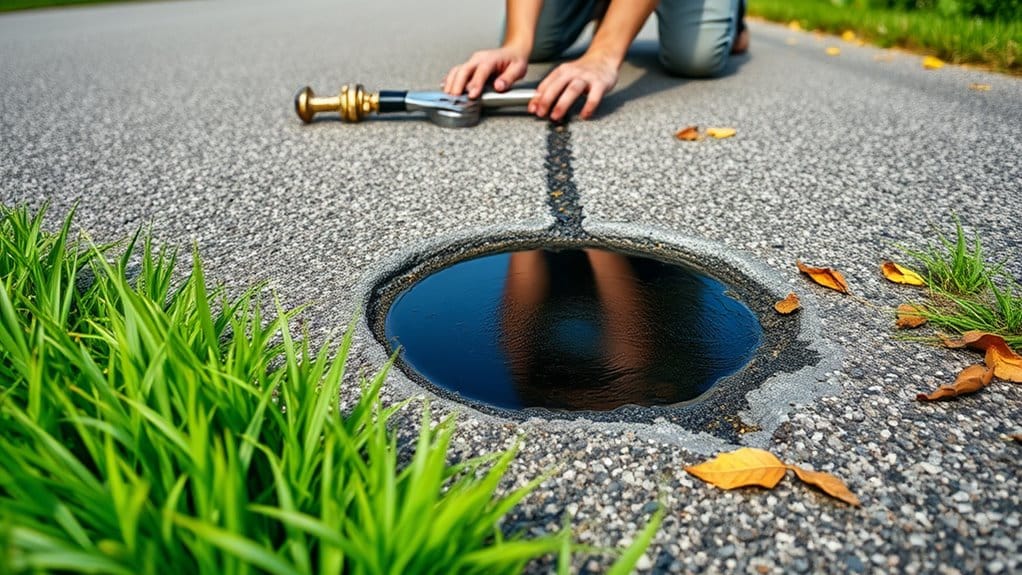
Maintaining your tarmac driveway goes beyond just applying sealant; it requires timely attention to cracks and potholes that can occur over time.
Regularly inspect your driveway to identify issues early. For filling cracks, clear away any debris with an air blower, then apply a suitable crack filler and smooth it with a trowel.
When dealing with potholes, first remove any loose dirt, then overfill the hole with cold-lay tarmac and compact it using a roller. Always make repairs in dry weather and allow the patches to cure for at least 24 hours.
To prevent potholes from forming, keep the surface clean, manage water pooling, and limit heavy traffic.
Regular maintenance is key to preserving your driveway's condition.
Seasonal Care and Maintenance
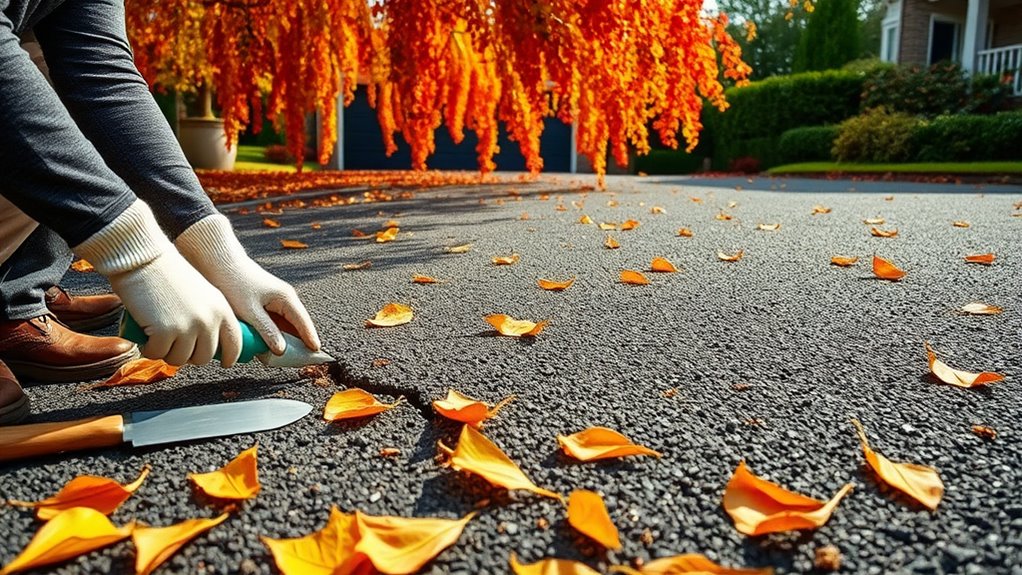
As the seasons change, it's important to adapt your tarmac driveway maintenance to keep it looking good and lasting longer. Each season brings its own set of challenges, so adjust your routine accordingly.
In spring, clear away debris and treat for weeds with a moss inhibitor.
Summer is the time to protect against UV damage by applying sealants and removing any rubbish.
In autumn, make sure to clear fallen leaves to stop moisture build-up and tackle weeds again.
During winter, steer clear of salt; instead, use sand for better traction.
Throughout the year, regularly inspect for stains and wear. Aim to pressure wash your driveway every 3-6 months and deal with any stains promptly to maintain its quality and appearance.
Preventative Measures for Longevity
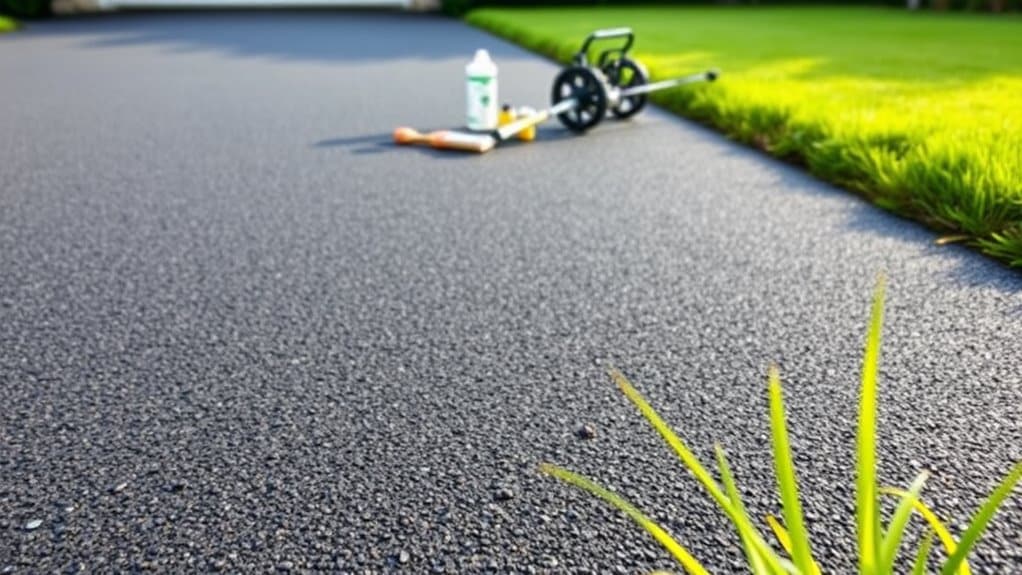
To ensure your tarmac driveway stands the test of time, it's important to take some straightforward preventative steps.
Firstly, distribute weight evenly when parking larger vehicles to avoid stressing the surface.
Secondly, keep an eye on nearby vegetation; roots can cause significant damage over time.
Lastly, try to limit traffic on your driveway to prevent unnecessary wear and tear.
Weight Distribution Techniques
Effective weight distribution techniques are crucial for extending the lifespan of your tarmac driveway. Proper load distribution reduces wear and prevents cracking, keeping your driveway in excellent condition.
Here are some essential strategies for managing weight effectively:
- Place plywood sheets beneath heavy machinery to evenly spread the load.
- Use edge restraints to support the tarmac and minimise the risk of cracking.
- Utilise load-spreading plates when using vehicle jacks to avoid concentrated pressure.
- Avoid parking in the same spot repeatedly to prevent uneven wear.
- Be mindful of weight limits to prevent undue stress on your driveway.
Vegetation Management Strategies
How can you keep your tarmac driveway free from invasive weeds? Start with effective vegetation management strategies.
Lay down weed control membranes beneath the tarmac to block sunlight and prevent seed germination. Regularly clear away debris like leaves and twigs to hinder weed growth. Fill any cracks promptly to maintain a smooth surface that deters weeds.
Consider using edging materials to create physical barriers along the edges of your driveway. For ongoing control, natural herbicides such as vinegar or salt solutions can be effective, but use them cautiously to avoid harming nearby plants.
Conduct seasonal inspections to spot and remove any weeds early. With proper landscape design and consistent maintenance, you can ensure your driveway stays in great condition for years.
Traffic Limitation Practices
Maintaining a tarmac driveway goes beyond managing weeds; it requires careful traffic control to ensure its longevity.
By adopting effective traffic limitation strategies, you can significantly reduce wear and tear on your driveway.
- Evaluate the volume of traffic to avoid overloading.
- Use clear signage to inform drivers of any restrictions.
- Install speed bumps to keep vehicle speeds in check.
- Combine multiple driveways to reduce potential conflict points.
- Introduce access control measures at busy junctions.
These measures not only improve safety but also prolong the lifespan of your driveway.
Regular Inspections and Record Keeping
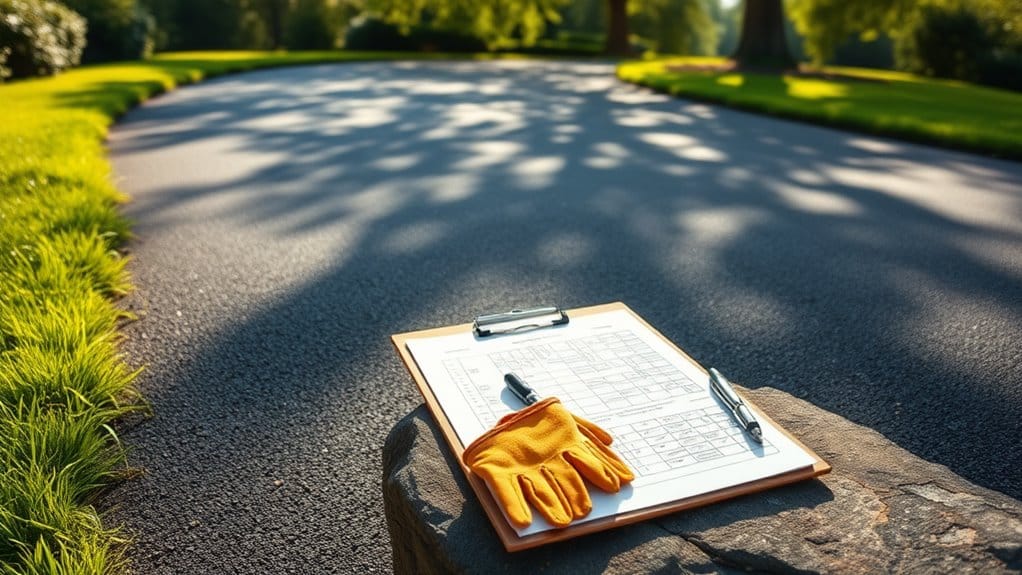
Regular inspections are vital for maintaining your tarmac driveway. They help you spot potential problems like cracks, potholes, and surface wear before they require expensive repairs.
Simple visual checks can reveal issues, and it's important to consider weather effects and look out for stains, weeds, and discolouration.
Keep a detailed maintenance log to record dates of inspections, tasks completed, and costs incurred. Note any recurring issues to better prepare for future maintenance and keep track of your suppliers for materials.
Frequently Asked Questions
How Often Should I Inspect My Tarmac Driveway for Damage?
You should inspect your tarmac driveway every 3 to 6 months. Regular checks improve tarmac durability and can extend the lifespan of your driveway by identifying issues early on, which helps prevent minor problems from turning into costly repairs. For instance, look out for cracks or surface wear that could worsen over time if left unattended.
What Signs Indicate It's Time to Reseal My Driveway?
When you see signs such as cracks, a faded appearance, or a rough texture on your driveway, it's time to reseal. Wear on your tarmac can lead to expensive repairs, so it's best to tackle these issues early to maintain both safety and aesthetics.
Can I Use a Regular Garden Hose for Pressure Washing?
A garden hose uses approximately 50% more water than a pressure washer, but it lacks the pressure needed for effective cleaning. For thorough cleaning tasks, such as removing grime from patios or driveways, a proper pressure washer is the better choice over a garden hose.
What Should I Do if I Find Large Cracks or Potholes?
If you come across large cracks or potholes, it's important to address them quickly. Start by clearing any debris and cleaning the affected area. Use suitable materials for repair, ensuring you compact them properly. After filling, consider sealing the surface to improve its durability and prevent future issues.
Are There Specific Weather Conditions That Affect Sealant Application?
Weather can greatly influence sealant application. It's essential to monitor temperature and moisture levels. The ideal conditions are between 13°C and 32°C with low humidity, as these ensure the best bonding and drying for your sealant. For example, applying sealant in damp conditions can lead to poor adhesion, while temperatures outside this range may prevent it from curing properly.
Conclusion
Following an annual maintenance schedule for your tarmac driveway not only improves its appearance but also extends its lifespan. A well-maintained driveway can enhance your property's value and curb appeal, making it a wise investment. By staying proactive with inspections and repairs, you can identify issues before they worsen, saving time and money in the long run. Remember, a bit of regular upkeep goes a long way in maintaining your driveway's integrity and functionality.
Prepare the perfect base for your resin bound stone installation and discover the crucial factors that ensure lasting durability.
Know where resin bound surfacing can transform spaces for both residential and commercial use, and discover the countless benefits that Read more
A stone carpet combines beauty and resilience in flooring, but what makes quartz floors uniquely beneficial? Discover the secrets behind Read more

